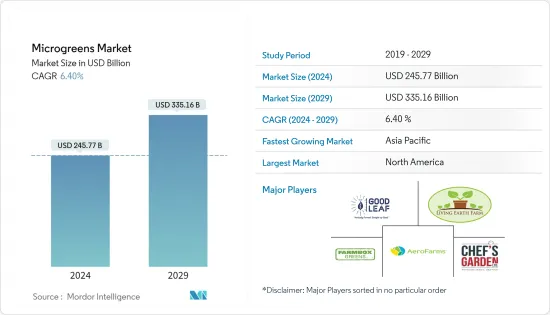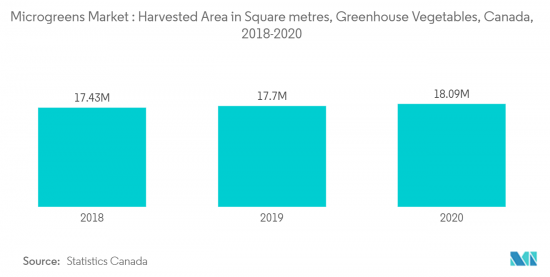PUBLISHER: Mordor Intelligence | PRODUCT CODE: 1405681

PUBLISHER: Mordor Intelligence | PRODUCT CODE: 1405681
Microgreens - Market Share Analysis, Industry Trends & Statistics, Growth Forecasts 2024 - 2029

The Microgreens Market size is estimated at USD 245.77 billion in 2024, and is expected to reach USD 335.16 billion by 2029, growing at a CAGR of 6.40% during the forecast period (2024-2029).
Key Highlights
- Microgreens are soft, tiny vegetable greens that are available for consumption. They are usually used to improve the color, texture, or flavor of various cuisines such as pasta, pizza, omelets, and salads due to their powerful aromatic flavor and range of colors and textures. The health benefits associated with the consumption of microgreens are they help manage weight, avoid chronic medical conditions, boost immunity, and improve mental health.
- The microgreens market is driven by chefs that use them as flavor enhancements and as colorful garnishes on their plates, but there is another niche industry that pushes new growth within this segment, cosmetics. These micro greens are processed into oils and ingredients for consumer items like shampoo and skincare products. Microgreens contain a lot of vitamins A and B in addition to many other micro-elements, making them very attractive ingredients for personal care product manufacturers. Over the long term, this is expected to boost the demand for microgreens.
- Broccoli, lettuce, arugula, and basil are some of the important microgreens grown across various regions through hydroponics and vertical farming. North America accounted for the largest market share in 2021. The United States is a major contributor to the share of the region, followed by Canada and Mexico.
Microgreens Market Trends
Rise in Adoption of Indoor Farming
The growing population has led to increased food demand which made farmers turn towards high-tech production methods like indoor farming because of the decrease in productive land. Along with this, the growing health consciousness has led people to consume a diet full of nutrients, which has led to the adoption of indoor farming practices. Consumers not only practice indoor farming at home, but it is also largely being cultivated in major greenhouses. Thus, the market for microgreens is anticipated to grow in the years to come. According to a survey by Artemis, an intelligence platform, almost 16% of growers in indoor cultivation are involved in microgreens production.
In addition to these factors, the increased acceptance of agricultural mechanization and increased knowledge of high-tech farming techniques like hydroponics, aeroponics, and aquaponics are anticipated to promote the expansion of the microgreens industry. With consumers across the world turning toward healthy diets, the demand is increasing, and the production of microgreens is anticipated to increase in the coming years. This rising adoption of protected cultivation has led the market to grow moderately.
Furthermore, in Canada, there has been a steady increase in greenhouse vegetable production, including microgreens, and it is anticipated that the multi-decade trend of growth will continue in the near future. The success of greenhouse technology is boosting the microgreens market. Thus, the revenue has stabilized with the growth in demand, which, in turn, has aided in the market growth.

North America is One of the Largest Markets for Microgreens
North America accounted for the largest share of the microgreens industry in 2021. The rise in the awareness of health benefits and balanced diets has made people in this region include green vegetable salads and organic-based food items including microgreens in their diets which is increasing the market for microgreens. With the help of enhanced indoor and vertical farming practices, US growers have been able to produce microgreens on a large scale. For instance, According to Agrilyst, an intelligence platform, the distribution of greenhouses in the United States in various areas varied, but the production of microgreens in greenhouses was most prevalent in the South and Northeast regions, accounting for 71% and 59%, respectively in 2020. Moreover, hydroponic farming generates the highest revenue for Californian farmers. Therefore, crops such as broccoli, lettuce, and salad vegetables are grown, which are best suited for this farming technique.
Many retailers are providing "Certified Naturally Grown" microgreen seeds to local restaurants and farmers in the United States, which can be grown hydroponically and through vertical farming in the country. Canadian farmers rely on indoor farming than greenhouse farming for growing microgreens because of the electricity needed for lighting. Growing indoors eliminates many of the pest and disease problems of outdoor production. Thus, organic farmers are tapping into this market due to the increased demand from chefs that use them as flavor enhancements and colorful garnishes.
Microgreens Industry Overview
The microgreens market is fragmented and highly competitive due to the presence of many major players. The key players in the microgreens market contributing to the market include Farmbox Greens LLC, The Chef's Garden Inc., Aerofarms LLC, Living Earth Farms, Good Leaf Farms, Jiangsu Skyplant Greenhouse Technology Co. Ltd, and Shanghai Dehuan Industry Co. Ltd. The major players are adopting new product launches and expansion strategies for global growth in the microgreens market.
Additional Benefits:
- The market estimate (ME) sheet in Excel format
- 3 months of analyst support
TABLE OF CONTENTS
1 INTRODUCTION
- 1.1 Study Assumptions
- 1.2 Market Definition and Scope of the Study
2 RESEARCH METHODOLOGY
3 EXECUTIVE SUMMARY
4 MARKET DYNAMICS
- 4.1 Market Overview
- 4.2 Market Drivers
- 4.3 Market Restraints
- 4.4 Value Chain Analysis
5 MARKET SEGMENTATION
- 5.1 Type
- 5.1.1 Broccoli
- 5.1.2 Lettuce and Chicory
- 5.1.3 Arugula
- 5.1.4 Basil
- 5.1.5 Fennel
- 5.1.6 Carrots
- 5.1.7 Sunflower
- 5.1.8 Radish
- 5.1.9 Peas
- 5.1.10 Other Types
- 5.2 Farming
- 5.2.1 Indoor Farming
- 5.2.2 Vertical Farming
- 5.2.3 Commercial Greenhouses
- 5.2.4 Other Farming
- 5.3 Growth Medium
- 5.3.1 Peat Moss
- 5.3.2 Soil
- 5.3.3 Coconut Coir
- 5.3.4 Tissue Paper
- 5.3.5 Other Growth Mediums
- 5.4 Distribution Channel
- 5.4.1 Hypermarkets/Supermarkets
- 5.4.2 Restaurants
- 5.4.3 Other Distribution Channels
- 5.5 Geography
- 5.5.1 North America
- 5.5.1.1 United States
- 5.5.1.2 Canada
- 5.5.1.3 Mexico
- 5.5.1.4 Rest of North America
- 5.5.2 Europe
- 5.5.2.1 Netherlands
- 5.5.2.2 Spain
- 5.5.2.3 Germany
- 5.5.2.4 France
- 5.5.2.5 Rest of Europe
- 5.5.3 Asia-Pacific
- 5.5.3.1 China
- 5.5.3.2 India
- 5.5.3.3 Singapore
- 5.5.3.4 Australia
- 5.5.3.5 Rest of Asia-Pacific
- 5.5.4 South America
- 5.5.4.1 Brazil
- 5.5.4.2 Chile
- 5.5.4.3 Argentina
- 5.5.4.4 Rest of South America
- 5.5.5 Middle East & Africa
- 5.5.5.1 Algeria
- 5.5.5.2 Saudi Arabia
- 5.5.5.3 Egypt
- 5.5.5.4 South Africa
- 5.5.5.5 Rest of Middle East & Africa
- 5.5.1 North America
6 COMPETITIVE LANDSCAPE
- 6.1 Most Adopted Strategies
- 6.2 Market Share Analysis
- 6.3 Company Profiles
- 6.3.1 AeroFarms LLC
- 6.3.2 Goodleaf Farms
- 6.3.3 Living Earth Farm
- 6.3.4 Farm Box Greens
- 6.3.5 Jiangsu Skyplant Greenhouse Technology Co. Ltd
- 6.3.6 Shanghai Dehuan Industry Co. Ltd
- 6.3.7 Chef's Garden Inc.
- 6.3.8 Madar Farms
- 6.3.9 Metro Microgreens
- 6.3.10 Gotham Greens
- 6.3.11 Greenbelt Microgreens
7 MARKET OPPORTUNITIES AND FUTURE TRENDS




